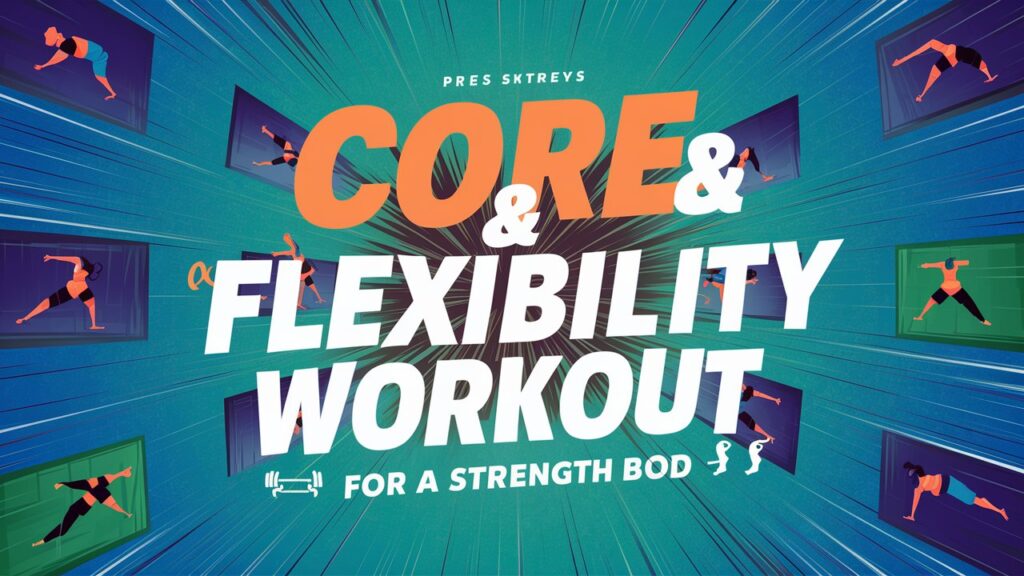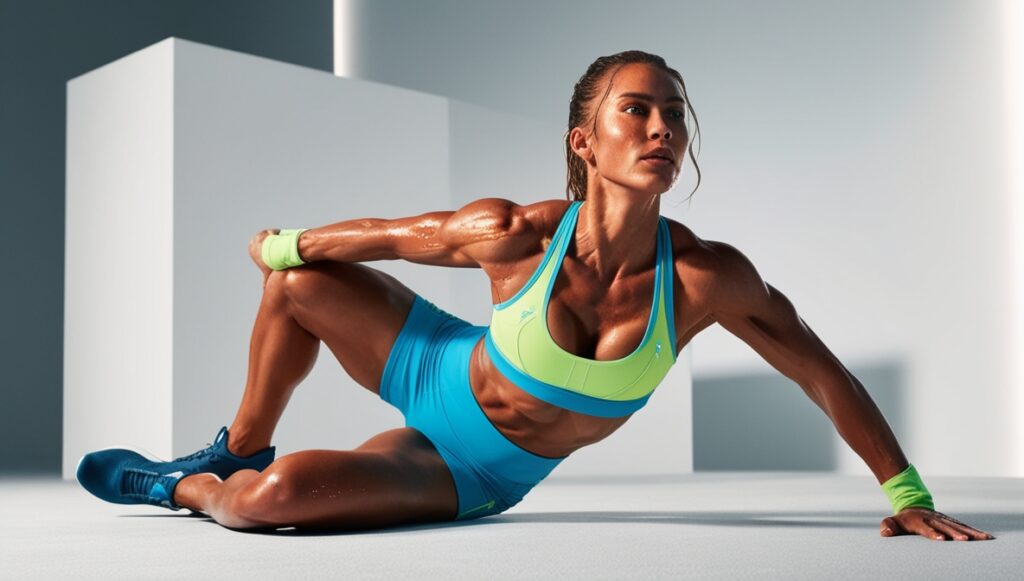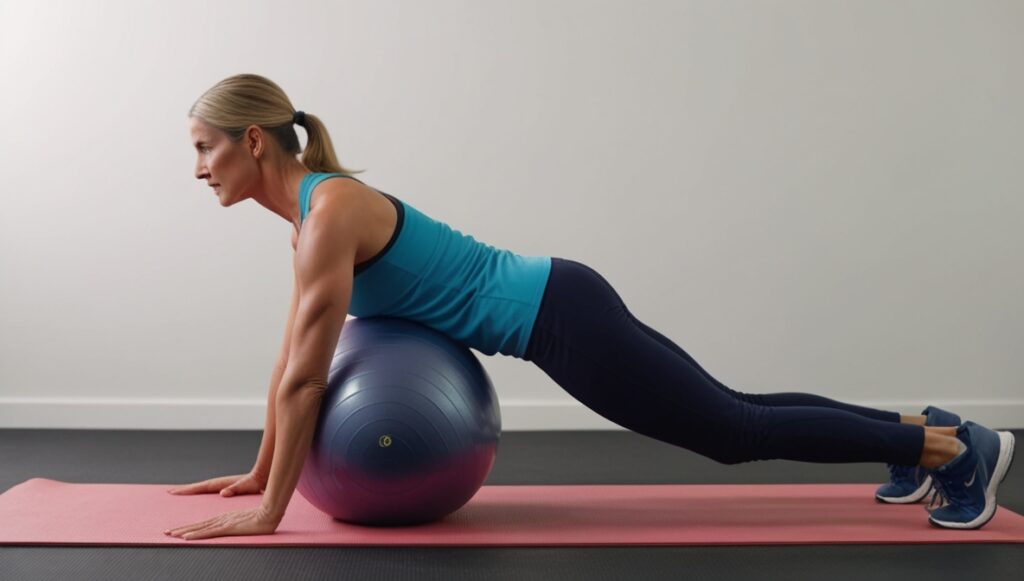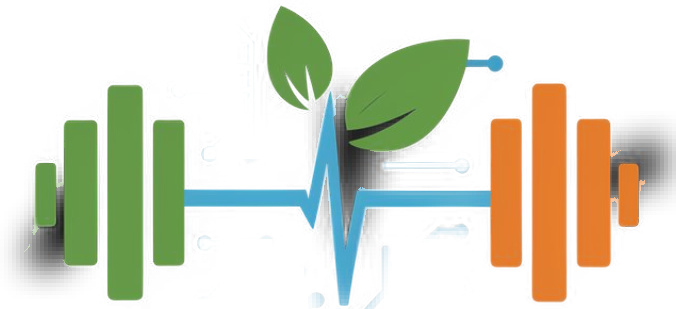Core and Flexibility Workout to Strengthen Your Body:

This workout focuses on strengthening the core with challenging exercises targeting the rectus abdominis, obliques, transverse abdominis, and the lower back.1 The flexibility exercises stretch the entire body with a focus on the back and hips. Do this workout after your regular cardio workout or on its own for a challenging, yet relaxing, workout.
Table of Contents
In the realm of fitness, the significance of core strength and flexibility cannot be overstated. A robust core and a flexible body are foundational elements for overall physical health, contributing to improved posture, enhanced athletic performance, and reduced risk of injuries. This comprehensive guide explores the world of core and flexibility workouts, highlighting their benefits and providing practical advice on how to incorporate them into your fitness routine for a stronger, healthier body.
Understanding Core Workouts
Definition and Components of the Core
The core is more than just your abs. It encompasses a complex group of muscles, including the transverse abdominis, rectus abdominis, internal and external obliques, and the muscles of the pelvic floor, back, and hips. These muscles work together to stabilize the spine and pelvis, support movement, and maintain balance.
Importance of Core Strength
A strong core is essential for almost every movement you make. It supports your body in daily activities, enhances your athletic performance, and helps prevent injuries. Core strength is crucial for maintaining balance and stability, making it easier to perform both simple and complex tasks.
Types of Core Muscles
- Transverse Abdominis: The deepest layer of abdominal muscles, crucial for stabilizing the spine.
- Rectus Abdominis: Commonly known as the “six-pack” muscles, these are involved in movements like bending forward.
- Internal and External Obliques: Located on the sides of the abdomen, these muscles help with twisting and side-bending movements.
- Pelvic Floor Muscles: These support the bladder, bowel, and uterus and contribute to core stability.
- Back Muscles: Including the erector spinae, which help with posture and movement.
Equipment Needed:
To complete this workout, you will need an exercise ball, a medicine ball, a resistance band, and a mat.
How To
- Warm up with light cardio or do this workout after your regular cardio workout
- Modify exercises when necessary.
- Do this workout 2 to 3 times a week with a day of rest in between.
1.Bird Dog
Verywell / Ben Goldstein
- To do a bird-dog, begin on hands and knees. Engage the abs and lift the right arm and left leg until level with the body, holding your balance and keeping your torso tight.
- Lower back down and repeat with the left arm and right leg.
- Repeat for 2 sets of 12 reps, alternating sides (one rep includes both the right and left sides).
2.Med Ball Rotations on the Ball

- Lie with the exercise ball under your shoulders, neck, and head. Your hips should be lifted in a bridge position
- Take the arms straight up over the chest holding a light weight or medicine ball.
- Tighten your abs and rotate your torso to the left as far as you can, allowing the hips and legs to move naturally with the motion.
- Return to center, then go to the other side for 2 sets of 12 reps on each side (one rep includes both the right and left sides).
3.Forearm Side Plank
:max_bytes(150000):strip_icc():format(webp)/forearm-side-plank1-756bdcdb658c4cbabb41a107fb0523e9.png)
- Lie on your side balanced on the forearm, feet and hips stacked on top of one another.
- Holding the torso steady, slowly contract your abs and lift the hips off the floor (don’t sink into the shoulder). Lower and repeat.
- If you experience discomfort in the shoulder, the hip does not need to come all the way to the floor. Simply lower as much as you can while keeping the shoulders comfortable.
- Repeat for 2 sets of 10 reps on each side.
4.Seated Torso Twist
:max_bytes(150000):strip_icc():format(webp)/woman-training-in-gym-562603647-5bfdafcf46e0fb00518c1f87.jpg)
- Sit holding a medicine ball at chest level. Bend the knees, lean back slightly and lift the feet off the floor. The torso should remain straight with the abs engaged.
- Rotate the chest to the right and touch the medicine ball to the floor near the right hip.
- Bring the torso back to center and rotate the chest to the left. Touch the ball down near the left hip. Return to center and continue the sequence side to side.
- If you are not able to maintain the feet off the floor with a long, tall torso, keep the feet on the floor and simply rotate side to side holding the ball at chest height.
- Repeat, alternating sides for 2 sets of 10 reps (one rep is to the right and left).
5.Plank
:max_bytes(150000):strip_icc():format(webp)/10-Plank-56f99b9e5f9b5829866fe6f3.jpg)
- Place forearms on the floor and press up into a flat-back position on the toes, keeping the hips down so that the body is in a straight line from head to heels.
- Hold for 30 to 60 seconds, lower, and repeat.
- To modify, take one or both knees to the floor.
6.Woodchop
Verywell / Ben Goldstein
- To do a woodchop, you can use a cable, or attach one end of a resistance band to something sturdy on your right side at shoulder height or higher.
- With feet placed hip-distance apart, grasp the handle with both hands and sweep the arms down on a diagonal across the body and past the opposite thigh. Your torso, hips, and knees will rotate slightly during this fluid movement.
- Control the reverse movement, slowly allowing the handles to retract to their starting position.
- Repeat for 2 sets of 12 reps on each side.
7.Ab Roll

- Kneel in front of the exercise ball and place your hands on the ball parallel to one another. Roll the ball out, keeping the hips and back straight.
- Roll out until you feel the abs engage (don’t arch or strain the back) and push into the ball to roll back in.
- Repeat for 2 sets of 10 reps.
8.Hamstring Stretch
:max_bytes(150000):strip_icc():format(webp)/About-47-12311150-Standing-Ham-Stretch01-633-5b042556ff1b780020bc9286.jpg)
- From a standing position, take the left foot in front of you, your foot flexed, and tip from the hips, lowering the torso until you feel a stretch in the left hamstring.
- Keep the back flat and hold for 15 to 30 seconds, repeating on the right leg.
9.Quad Stretch
:max_bytes(150000):strip_icc():format(webp)/About-6-2911936-Quad-Stretch01-095-5b032582875db90036cb6094.jpg)
- Hold onto a wall for balance if needed and bend the left knee, taking the heel towards the glutes.
- Grab onto the foot with your left hand, keeping the knee pointing toward the floor, and feel a stretch in the front of the leg.
- Hold for 15 to 30 seconds and repeat on the other side.
10.Shoulder Stretch
:max_bytes(150000):strip_icc():format(webp)/StandingShoulderStretch_annotated-10753f1346104c38b89db3e2d36d5dc7.jpg)
- Take your right arm straight across your chest and curl the left hand around your elbow, gently pulling on the right arm to deepen the stretch in the shoulder.
- Hold for 15 to 30 seconds and switch sides.
11.Hip Figure 4 Stretch
Lie down on the mat on your back. Cross your left foot over the right knee.
- Clasp your hands behind your right thigh and gently pull the leg in towards you, keeping the upper body relaxed.
- Hold for 15 to 30 seconds and switch sides.
12.Pigeon Stretch
Begin on the hands and knees and bring the left knee in, resting it on the floor between your hands (you should be on the outside of the knee).
- Straighten the right leg out behind you and, if you can, bend forward and rest the forearms on the floor.
13.Knee Drops
:max_bytes(150000):strip_icc():format(webp)/woman-in-tank-top-and-shorts-lying-on-back-on-blue-mat--arms-lying-straight-out-at-sides--hips-twisted-to-one-side--performing-side-roll-98955720-5bfdb292c9e77c0026fccb31.jpg)
- Start on your back on the floor. Bring the knees up and bend them to 90 degrees, shins parallel to the floor and arms out to the sides.
- Contract the abs and rotate the torso to lower the legs to the right, bringing them down to the floor. Keep the left shoulder flat on the floor and release any tension in your waist and back.
- Hold the stretch for about 5 breaths. Bring the knees back to center and repeat on the other side.
14.Spine Twist
Lying on the floor, place your right foot on the left knee.
- Using your left hand, gently pull your right knee towards the floor, twisting your spine and keeping your left arm straight out, hips and shoulders on the floor.
- Hold for 15 to 30 seconds and switch sides.
15.Side Child’s Pose
Verywell / Ben Goldstein
- Use this modified child’s pose to get an extra side stretch. Begin on your hands and knees, sit back onto the heels, walk the hands forward, and stretch the arms out. You can take the knees wide if that’s more comfortable.
- Relax your forehead on the floor and walk the hands a few inches to the right, feeling a stretch down the left side.
- Hold for a few breaths before walking the hands to the right and holding there.
Benefits of Core Workouts
- Improved Balance and Stability
- A strong core helps maintain balance during activities and reduces the risk of falls.
- Enhanced Athletic Performance
- Core strength is essential for power, speed, and agility in sports.
- Reduced Risk of Injury
- A strong core supports proper alignment and reduces strain on the spine and joints.
- Better Posture
- Core exercises strengthen the muscles that support good posture, reducing back pain and improving overall appearance.
Understanding Flexibility Workouts
Definition of Flexibility
Flexibility is the ability of a muscle or muscle group to lengthen and move through a range of motion around a joint. It is a key component of overall fitness, allowing for greater freedom of movement and reducing the risk of injuries.
Importance of Flexibility
Flexibility is crucial for maintaining the full range of motion in the joints, which is necessary for performing daily activities and exercises with ease. It also helps prevent injuries, reduces muscle soreness, and enhances physical performance.
Types of Flexibility
- Static Flexibility
- Involves holding a stretch for a prolonged period without movement.
- Dynamic Flexibility
- Involves moving parts of the body through a full range of motion.
- Ballistic Flexibility
- Involves using momentum to stretch the muscles beyond their typical range of motion.
Types of Flexibility Workouts
Static Stretching
- Hamstring Stretch
- Stretches the back of the thigh.
- How to do it: Sit on the ground with one leg extended, and reach for your toes.
- Quadriceps Stretch
- Targets the front of the thigh.
- How to do it: Stand on one leg, pull your other foot towards your buttocks, and hold.
- Shoulder Stretch
- Stretches the shoulder and upper back.
- How to do it: Bring one arm across your body, and use the other arm to pull it closer.
Dynamic Stretching
- Leg Swings
- Loosens up the hips and legs.
- How to do it: Stand on one leg, swing the other leg forward and backward.
- Arm Circles
- Warms up the shoulders.
- How to do it: Extend your arms to the sides and make small to large circles.
- Walking Lunges
- Stretches the hip flexors and quadriceps.
- How to do it: Step forward into a lunge, alternating legs as you move forward.
Yoga and Pilates
- Downward Dog
- Stretches the hamstrings, calves, and back.
- How to do it: Start on all fours, lift your hips, and form an inverted V-shape.
- Child’s Pose
- Relaxes and stretches the lower back and hips.
- How to do it: Sit back on your heels, stretch your arms forward, and rest your forehead on the ground.
- The Hundred
- Engages the core while stretching the back and shoulders.
- How to do it: Lie on your back, lift your legs and shoulders, and pulse your arms up and down.
Benefits of Flexibility Workouts
- Increased Range of Motion
- Flexibility exercises help maintain and improve joint mobility.
- Improved Circulation
- Stretching increases blood flow to the muscles, aiding in recovery.
- Reduced Muscle Tension
- Regular stretching helps relax tight muscles and reduces pain.
- Enhanced Relaxation and Stress Relief
- Flexibility exercises, especially yoga, promote relaxation and mental well-being.
Combining Core and Flexibility Workouts
Importance of a Balanced Workout Routine
A balanced workout routine that includes both core and flexibility exercises ensures comprehensive fitness benefits. Combining these workouts improves overall strength, mobility, and endurance, leading to a healthier and more resilient body.
How to Integrate Core and Flexibility Exercises
- Warm-Up: Start with dynamic stretches to prepare your muscles.
- Core Workout: Perform static and dynamic core exercises.
- Flexibility Session: Conclude with static stretches to enhance flexibility and aid recovery.
Sample Combined Workout Plan
- Warm-Up (5-10 minutes)
- Arm circles, leg swings, walking lunges
- Core Workout (20-30 minutes)
- Plank (3 sets of 30 seconds)
- Russian twists (3 sets of 15 reps each side)
- Mountain climbers (3 sets of 20 seconds)
- Flexibility Session (10-15 minutes)
- Hamstring stretch (hold for 30 seconds each leg)
- Quadriceps stretch (hold for 30 seconds each leg)
- Child’s pose (hold for 1 minute)
Preventive Measures and Safety Tips
Warm-Up and Cool-Down Routines
Always start your workout with a proper warm-up to prepare your muscles and joints for exercise, and end with a cool-down to aid recovery and reduce muscle soreness.
Proper Form and Technique
Maintaining proper form and technique is crucial to prevent injuries and maximize the effectiveness of your exercises. If you’re unsure, consider seeking guidance from a fitness professional.
Listening to Your Body
Pay attention to your body’s signals. If you experience pain or discomfort, stop the exercise and consult a healthcare provider if necessary.
Personal Stories and Case Studies
Testimonials from Individuals Who Improved Their Fitness
Many individuals have transformed their fitness levels by incorporating core and flexibility workouts. These exercises have helped them achieve better posture, enhanced performance in sports, and reduced the risk of injuries.
Real-Life Success Stories
- John’s Journey
- John, a 35-year-old office worker, struggled with back pain due to prolonged sitting. After incorporating core and flexibility exercises into his routine, his posture improved, and his back pain diminished significantly.
- Emma’s Experience
- Emma, a 28-year-old yoga enthusiast, found that adding core workouts to her practice enhanced her stability and allowed her to perform more advanced poses with ease.
Expert Insights
Advice from Fitness Trainers and Physiotherapists
Experts agree that core and flexibility workouts are essential for overall fitness. They recommend starting with basic exercises and gradually increasing intensity and duration to avoid injuries.
Research Findings on Core and Flexibility Workouts
Studies show that individuals who regularly engage in core and flexibility exercises experience fewer injuries, improved posture, and enhanced athletic performance. These exercises are also linked to better mental health and reduced stress levels.
Incorporating core and flexibility workouts into your fitness routine is a powerful way to build a stronger, healthier body. These exercises offer numerous benefits, from improved balance and stability to enhanced relaxation and stress relief. Start today by integrating these workouts into your routine and experience the transformative effects on your physical and mental well-being. Commit to your fitness journey and take the first step towards a more resilient and flexible body.
- Also Read :
- Zone 2 Cardio: Benefits, Heart Rate Zones, and Training Guide
- 6 Cardio Workouts You Can Do At The Gym
- Effective Cardio Workouts at Home for Weight Loss
- Cardio Before or After Weights: Maximize Your Workout
FAQs:
What are core workouts, and why are they important?
Core workouts focus on strengthening the muscles in your abdomen, back, and pelvis. These muscles are essential for stabilizing your spine, maintaining balance, and supporting everyday movements. Strong core muscles enhance athletic performance, improve posture, and reduce the risk of injuries.
What are some effective core exercises for beginners?
For beginners, effective core exercises include:
Plank: Hold a push-up position with a straight body.
Side Plank: Lie on your side, lift your hips, and hold your body in a straight line.
Bicycle Crunches: Lie on your back, lift your legs and shoulders, and alternate bringing your elbows to your opposite knees.
What is flexibility, and why is it essential?
Flexibility is the ability of a muscle or muscle group to move through a range of motion. It is essential for maintaining joint mobility, preventing injuries, reducing muscle soreness, and enhancing overall physical performance.
What types of flexibility exercises are there?
There are three main types of flexibility exercises:
Static Stretching: Holding a stretch for a prolonged period without movement (e.g., hamstring stretch).
Dynamic Stretching: Moving parts of the body through a full range of motion (e.g., leg swings).
Ballistic Stretching: Using momentum to stretch muscles beyond their typical range of motion (not recommended for beginners).
